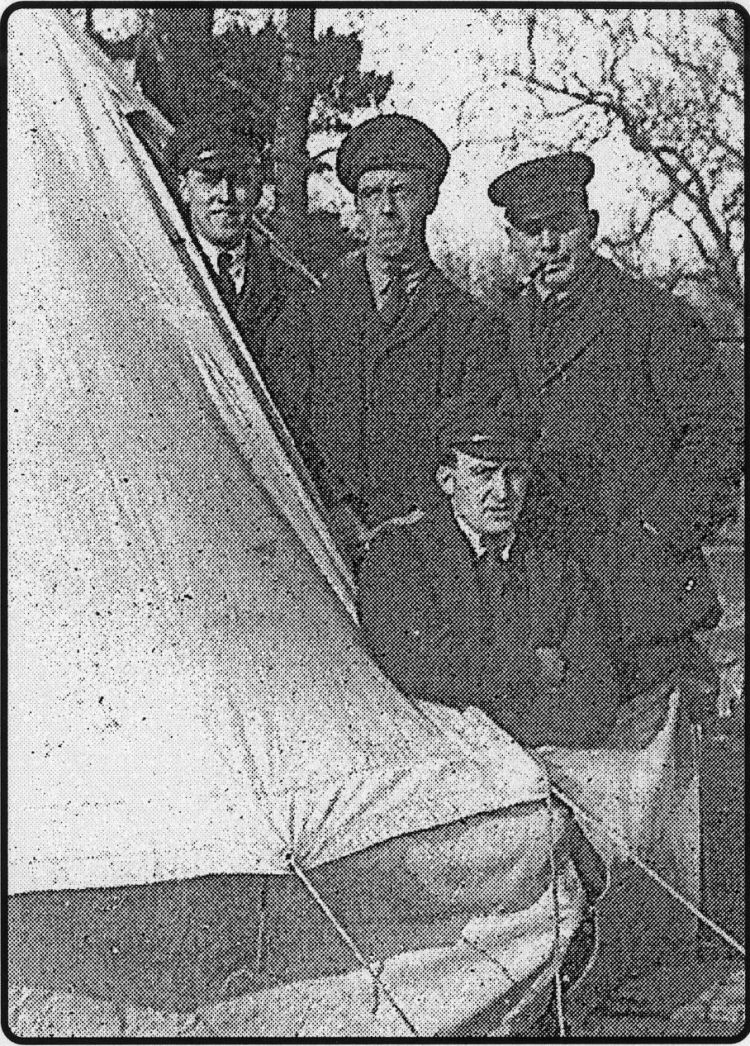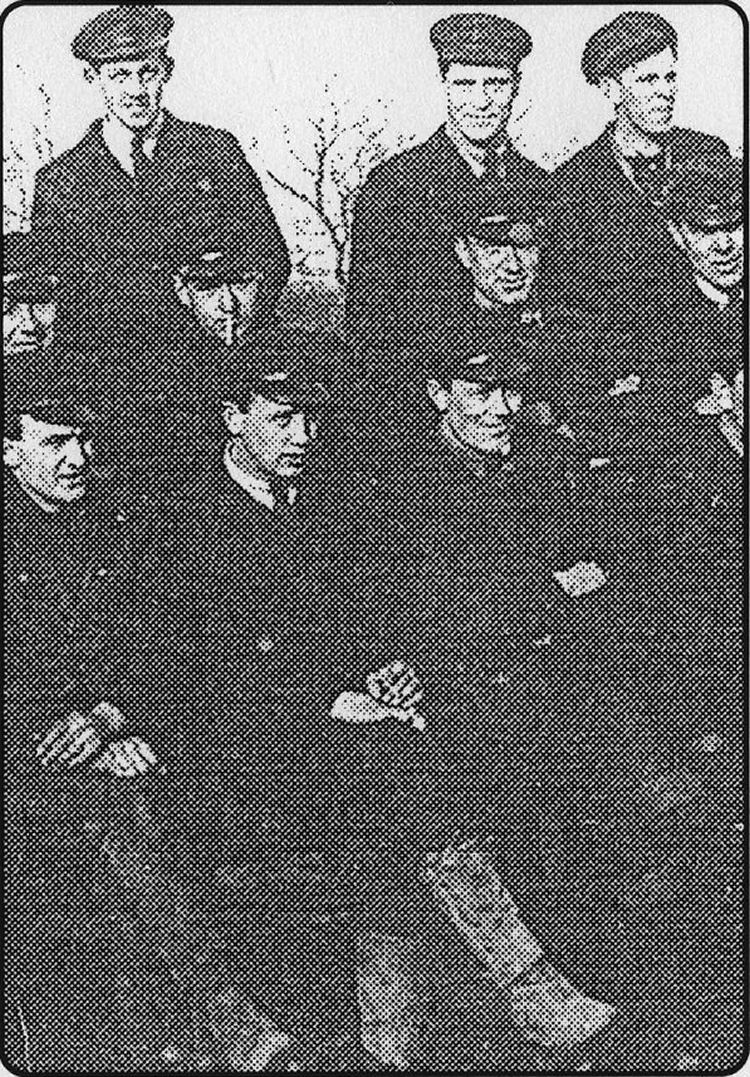
Published 22 March 2001

ous accident, was quite a rare one.
The R.34 commenced trials at Inchinnan, in Scotland, on March 14,1919, the
Royal Navy accepting her in late May 1919.
Roy tells me that on July 2, 1919 she began a successful double crossing of
the Atlantic, landing at Long Island, USA, after 108 hours 12 minutes flying
time. She landed back at Pulham, Norfolk after 75 hours
2 minutes. She was then refitted at East Fortune, in Scotland, before
returning to Pulham in February 1920.
The late Mr Scowen's photo was of the scene when she was wrecked by
gale-force winds at her mast at Howden, in Yorkshire. This was shortly after
another mishap!
She struck a hill-top at Guisborough Moor during a flight from Howden in
January 1921 with eight American
flew back to Howden the next day. No one was killed in either incident. Only
a guard watch was on board her at Howden and they soon evacuated 'ship' when
her destruction seemed inevitable. This time there was no repair - she was
scrapped.
One of the photographs in my earlier Memories feature was of Harold Scowen,
suspended, all alone, in the basket of a small airship, or kite balloon,
high above the Channel.
Built at Capel
The picture was taken by his colleagues who played a practical joke on him.
That kite balloon, Roy Humphreys told Derrick - a railway worker at Ashford
before retirement - was constructed at Dover and then transferred to Capel
RNAS station. Further balloons were built at Capel
Squadron Leader. Roy discovered the two men were photographed at Pulham
after the return flight of the airship R.34.
They were Major G.H. Scott, the R.34 captain, who was later killed in the
R.101 airship disaster, and Wing Commander F.L.M. Boothby, C.O. at Pulham.
Personnel at the Capel air station were living under canvas while the site
was being developed in 1914-15, and two pictures show the men by their bell
tents, including Harold Scowen.
An airship hangar is apparently being completed or extended in another
photo. This, apparently, was not taken at Capel, but may have been taken at
Polegate, over the border, in Sussex, says Roy.
Another of Mr Scowen's pictures shows some of the crew of the R.34 at Pulham,
in 1919. A couple of the men wear the
Aviation historian seeks readers’ help
LOCAL aviation historian and author Roy Humphreys, of Hawkinge, was very
interested in a Memories feature, back in January, about the Capel Airship
Station of the First World War. And he has been busy identifying and dating
photographs from the late Harold Scowen, copies of which were shown to me by
his nephew Derrick Lawson, of Lynwood, Folkestone. Two of them were used in
my article.
It appears that the photo trainee navigators on board. from 1915 to 1918. of
the airshin R-34 the nose The hill-top incident was evi- Another rare photo,
not un-
of which had met with a seri- £ent|V "ot verV .se.riou* a
because she was repaired and of two RAF flyers, one a
‘O' badge of the observer/gunner, which was only used by the RFC or RAF. It
was taken after April 1 1918 when Royal Naval Air Service and RFC personnel
began to mix in units of the RAF.
Help wanted
ROY Humphreys, who can be contacted on 01303 893476, told me he is
desperately trying to organise a data
base system for the Kent Aviation Historical Research Society (KAHRS) of
which he is an active member.
This is to hold every aspect of the county's aviation history over the past
century.
"Looking at my own files I have found many gaps of photographic evidence
supporting any running commentary on various locations," he says.
"To bring the data base up to a high level of excellence I need
- in the first instance - to find photographic evidence of the former Royal
Flying Corps aerodrome at St Mary's Bay, New Romney, known as Jesson Lane or
Littlestone," and, says Roy he would welcome the help of Herald readers.
"If anyone has photographic evidence taken at this location, at any time
from 1917 onwards, I seek their cooperation before such evidence is lost,"
he says.
ROYAL Naval Air Service crew who served at Capel Airship Station - now a
static caravan site
- in the First World War. Their function was to hunt for enemy submarines in
the Channel, using small airships and kite balloons which were kept in large
hangars. These hangars were later used as a garage by a local bus company
operating Silver Queen coaches, which took their names from the "Silver
Queen" airships. On the left is part of a large group of 20 airmen, some
wearing heavy flying boots. Bottom left is Harold Scowen, of Folkestone, who
is also seated above in a group of airmen outside one of the bell tents in
which they were quartered before more permanent airfield huts were built.

 |
Women urged to fight a ‘plague of mud’ in town
QA4 A HOUSEWIFE describing herself J.7UX simply as a “Lady Voter” wrote
to the Herald to join the mounting protest at the worsening state of the
town's roads. She said she was not so much concerned with arguments as
to the cause “But I do know that the mud finds its way into our houses,
it is fast spoiling our carpets, rugs, linoleum etc. and this in spite
of a good supply of mats. Charwomen are grumbling and good servants
(always difficult to keep) are leaving our employ, and all on account of
this curse of mud which appears to have fallen upon this once clean and
trim town.... Our dresses and petticoats, after five minutes’ walk are
In a shocking state.” And she went on to say that while rates were
rising “nothing appears to have been done to remove this veritable
plague of mud.' She added that women should band together to get action.
Conditions must have been in a very serious state for a woman to write
to a newspaper in those days. But was this an early sign of women
beginning to assert themselves?
|
Massive coast work at Sandgate begun
"f QC1 A £173,750 scheme was revealed to JLXt OX strengthen sea defences
at Sandgate and in particular the sea wall between Sea Point, Sandgate
and the Riviera, Folkestone, using a barrier, or curtain of steel to
keep out the sea and reduce erosion. This followed a report from expert
consulting engineers. Work started in front of Devonshire Terrace where
cracks had recently appeared in the road in front, next to the beach.
There was disappointment in the town when the Council, having decided to
withdraw a proposed Folkestone tableau in the Festival of Britain
Pageant to be held In Canterbury agreed to retain the: £250 contribution
from the rates, rather than allocate it to the town’s own Festival
celebrations. Later they relented and gave £100 towards the guarantor's
fund for the four-day Floral Festival, in July. Folkestone hit a high
note on the soccer front, the town's first team beating Faversham 4-0 in
the Kent League, with a hat-trick by Wiltshire, the Reserves beat
Wlngets 3-0 and Folkestone Boys beat Deal & Sandwich Boys 4-1. But Hythe
crashed at home 3-6 to Birchington in a Kent Amateur League game.
Lloyd's signal station at Dungeness was due to close down.
|
Public meeting told of a 'Message from Mars!’
"1 QOfi HARBOUR Garage, at 1 Sandgate Road, was advertising for £590, a
13 hp Lagonda 4-seater soft-top semi-sports car capable of SOmph and 33
miles per gallon. A notice for a Men’s Brotherhood: meeting announced
Joseph Clark, of London, was to give a ‘recital’ called “A Message from
Mars,” which is quite topical at the moment! In another column there was
a report on a Lyminge livestock market where 14 prime fat cattle, 145
fat sheep, 21 suckler calves, 230 fat and store pigs and 134 head of
poultry, were for sale, as wed as 1,550 dozen eggs, 50 lbs of farm
butter, potatoes and other produce was available; 1st quality beef made
19 shillings per score; 2nd quality, 17 shillings; fat cows, 14s; Kent
wether mutton, 8.75s a stone; Kent barren mutton, 7s per stone; half
bred mutton 10s a stone; roasters and fat hogs, 22s a score or store
pigs 43s each. Friends and family were mourning the death of licensee
James Tunbridge, 74, who, in his youth, was one of the first workers on
the site of the original Channel Tunnel scheme, at Shakespeare Halt,
where coal was first found and the ill-fated Dover Colliery was later
started and then foundered.
|
Conflict of views over bid to woo foreign shoppers
•f Q*7£THE MAYOR of Folkestone was visiting the •L*/f O Continent in a
bid to woo shoppers and sight-seers: to Folkestone and Hythe district
with a novel special passport scheme. But local shoppers were none to
happy about a weekend invasion of 1,000 odd Belgian shoppers from
Blankenberge. One woman complained of high prices and said the visitors
were clearing the shelves of some shops, as the shopkeepers cashed in.
Another complained of rudeness and several said that in the long term it
did more harm than good. The Council approved the building of homes for
650 people at East Cliff and Downs Road, In Folkestone and at
Reachfields, Hythe. But the design of some homes, at East Cliff was
described as like postwar prefabs. All bar one of 83 Folkestone pilots
working for Trinity House voted to stay with Trinity House as the
government planned to centralise pilotage. Captain Norman Knowles warned
that a central body would make for an expensive and remote service. A
bid was made to get action to prevent flooding in Hythe High Street. It
was claimed it was so bad insurance companies were refusing protection
for some shops. One trader threatened to withhold a proportion of his
rates if action wasn’t taken. Shepway had been offered 49 acres of land
at the wartime fighter airfield at Hawkinge and improved leisure
facilities were one suggestion fur tne site.
|
|



